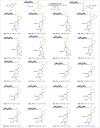Palladium-catalyzed Suzuki-Miyaura cross-couplings of stable glycal boronates for robust synthesis of C-1 glycals
- PMID: 38898022
- PMCID: PMC11187158
- DOI: 10.1038/s41467-024-49547-9
Palladium-catalyzed Suzuki-Miyaura cross-couplings of stable glycal boronates for robust synthesis of C-1 glycals
Abstract
C-1 Glycals serve as pivotal intermediates in synthesizing diverse C-glycosyl compounds and natural products, necessitating the development of concise, efficient and user-friendly methods to obtain C-1 glycosides is essential. The Suzuki-Miyaura cross-coupling of glycal boronates is notable for its reliability and non-toxic nature, but glycal donor stability remains a challenge. Herein, we achieve a significant breakthrough by developing stable glycal boronates, effectively overcoming the stability issue in glycal-based Suzuki-Miyaura coupling. Leveraging the balanced reactivity and stability of our glycal boronates, we establish a robust palladium-catalyzed glycal-based Suzuki-Miyaura reaction, facilitating the formation of various C(sp2)-C(sp), C(sp2)-C(sp2), and C(sp2)-C(sp3) bonds under mild conditions. Notably, we expand upon this achievement by developing the DNA-compatible glycal-based cross-coupling reaction to synthesize various glycal-DNA conjugates. With its excellent reaction reactivity, stability, generality, and ease of handling, the method holds promise for widespread appication in the preparation of C-glycosyl compounds and natural products.
© 2024. The Author(s).
Conflict of interest statement
The authors declare no competing interests.
Figures








Similar articles
-
Copper-Catalyzed Stereoselective Borylation and Palladium-Catalyzed Stereospecific Cross-Coupling to Give Aryl C-Glycosides.Chemistry. 2023 Jan 27;29(6):e202203376. doi: 10.1002/chem.202203376. Epub 2022 Dec 8. Chemistry. 2023. PMID: 36344464
-
Preparation of Synthetic and Natural Derivatives of Flavonoids Using Suzuki-Miyaura Cross-Coupling Reaction.Molecules. 2022 Jan 31;27(3):967. doi: 10.3390/molecules27030967. Molecules. 2022. PMID: 35164232 Free PMC article.
-
Pd-Catalyzed Stereospecific and Ligand-Controlled Regiodivergent Suzuki-Miyaura Cross-Coupling for the Synthesis of 3-C-Glycals and 2,3-Unsaturated C-Glycosides.Angew Chem Int Ed Engl. 2025 Aug 18:e202511045. doi: 10.1002/anie.202511045. Online ahead of print. Angew Chem Int Ed Engl. 2025. PMID: 40823895
-
Suzuki-miyaura cross-coupling in acylation reactions, scope and recent developments.Molecules. 2013 Jan 17;18(1):1188-213. doi: 10.3390/molecules18011188. Molecules. 2013. PMID: 23344208 Free PMC article. Review.
-
The Liebeskind-Srogl cross-coupling reaction towards the synthesis of biologically active compounds.Eur J Med Chem. 2025 Jun 5;290:117526. doi: 10.1016/j.ejmech.2025.117526. Epub 2025 Mar 20. Eur J Med Chem. 2025. PMID: 40184777 Review.
Cited by
-
Zweifel olefination for C-glycosylation.Commun Chem. 2024 Dec 21;7(1):306. doi: 10.1038/s42004-024-01339-4. Commun Chem. 2024. PMID: 39709475 Free PMC article.
References
MeSH terms
Substances
LinkOut - more resources
Full Text Sources
Other Literature Sources

